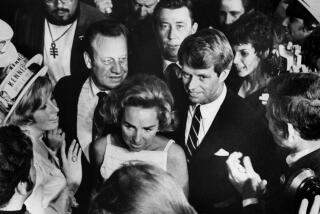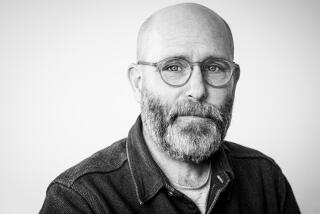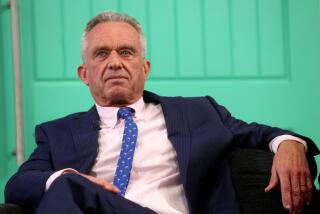Bill Eppridge dies at 75; took famed photo of RFK after shooting
Life magazine photographer Bill Eppridge was on assignment taking pictures of wild horses in the Montana mountains in 1968 when he got word that Robert F. Kennedy was running for president.
“I jumped into my Jeep, drove about 20 miles down the worst roads in the world,” Eppridge said in a 2008 radio interview. He had photographed Kennedy in 1966 and was so taken with the senator that he desperately wanted to cover the presidential campaign. “I’ve got to do this,” he begged his editors.
The assignment ended tragically on June 5, 1968, with what is widely considered one of the greatest news photos of all time. Eppridge took the haunting picture of Kennedy slumped on the floor of the Ambassador Hotel in Los Angeles just after Kennedy was shot by an assassin, with busboy Juan Romero trying to comfort him.
Photo editor Karen Mullarkey, who worked with Eppridge at Life and other publications, described him as a brilliant photographer. “He went on to many other assignments,” she said. “But I believe in my heart that part of Bill perished that night.”
Eppridge, 75, died Thursday in a Danbury, Conn., hospital after a short illness, according to his wife, Adrienne Aurichio.
His friend Bill Snead, former photo director at the Washington Post, said Eppridge had recently suffered a fall.
Eppridge had taken other revered photos in his long career working for numerous publications. In 1964 he shot the landmark Life photo essay “Needle Park” about drug addicts in New York that inspired the 1971 film, “Panic in Needle Park.” He also photographed in Vietnam during the war years.
On the lighter side, he captured the Beatles’ first appearances in the U.S., the Woodstock music festival and a young Barbra Streisand in her tiny New York flat.
Eppridge’s work is featured in several books, including “The Beatles: Six Days that Changed the World,” due out in February.
By his own admission, Eppridge sometimes got emotionally close to his photo subjects, even if they were politicians.
“Most journalists tried to maintain a separation between themselves and the politicians, and most accomplished that,” he said on the Leonard Lopate radio show on WNYC in 2008. But then there was Kennedy. “He was too powerful a figure for me to try and distance myself from him,” Eppridge said.
Bill Eppridge was born March 20, 1938, in Buenos Aires, where his father was a chemical engineer. After earning a bachelor’s degree in journalism from the University of Missouri, he worked for National Geographic. He started at Life magazine in 1964.
After leaving Life in 1972, he worked for other magazines including Time and Sports Illustrated.
Survivors in addition to his wife include two sisters, Randi Norum and Terry Eppridge. All were with him when he died, Aurichio said.
Though Eppridge was known as a boisterous, even brash figure at times who enjoyed a night on the town, he was not above helping young photographers just starting out.
One of them was David Hume Kennerly, a photojournalist who won acclaim for his Vietnam War pictures. But in 1966, Kennerly was a teenage photographer at the now-defunct Oregon Journal on assignment to take a picture of Kennedy on the campaign stump for a local candidate. “I got to the labor hall and it was totally crowded,” Kennerly said. “I was panicked and I asked a photographer standing there how I get through.”
That photographer was Eppridge. “He took pity on me,” Kennerly recalled, “and said, ‘Grab on to my coat,’ and he just sliced through the crowd.” When they got to the front, Eppridge even told him where to stand to get the best angle.
Two years later, Kennerly — then working for UPI — was also at the Ambassador Hotel when Kennedy was shot. Kennerly was at the back of the auditorium, not close up like Eppridge and others. Kennerly said none got as great a photo as Eppridge’s. “There was a light from the one TV guy who was there, and it gave the photo a kind of eerie sense. There is almost a religious feel to it,” he said.
The assassination and Eppridge’s role in recording it devastated him because of his long association with the candidate. “He practically lived with the guy,” Kennerly said. “He loved the guy.”
A fellow Life photographer in the 1960s, Bob Gomel, said Eppridge knew he had taken a picture that would live on.
“He said in effect he was no longer a photographer. He became a historian at that point,” Gomel said. “He meant the picture was of such consequence it became a moment in history.”
Mullarkey and others said Eppridge was never the same afterward. “You couldn’t look at Bill,” she said, “without seeing a bit of sadness in his eyes.”
Times writer Elaine Woo contributed to this report.
More to Read
Start your day right
Sign up for Essential California for the L.A. Times biggest news, features and recommendations in your inbox six days a week.
You may occasionally receive promotional content from the Los Angeles Times.







